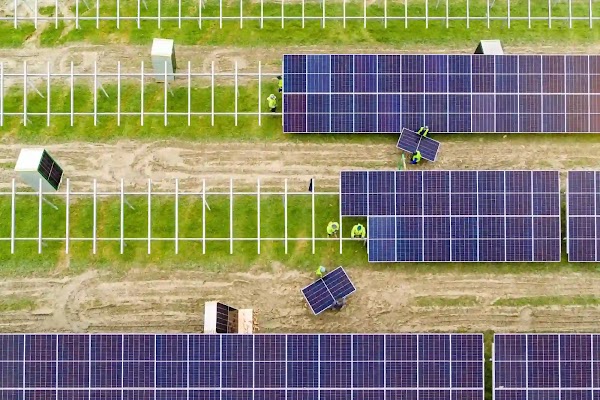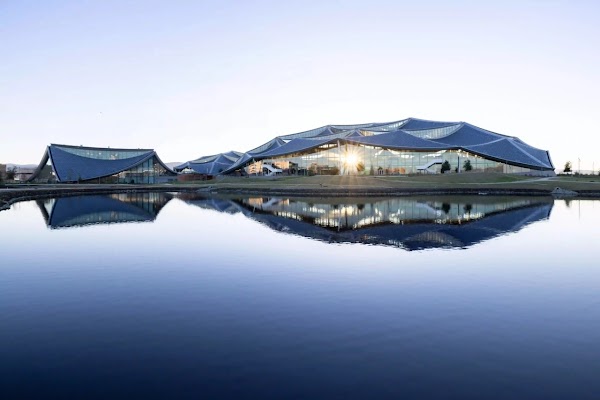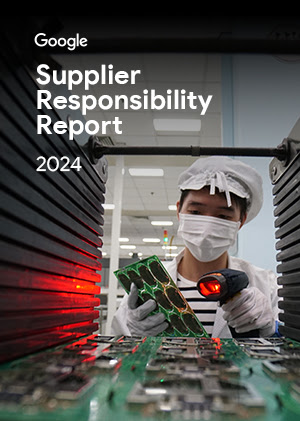Our operations
Innovating across our <br> operations and supply chain
Our operations
Innovating across our
operations and supply chain




-
Pursue net-zero emissions
We’ve set a goal to achieve net-zero emissions across all of our operations and value chain by 2030.1
Learn moreAdvance our standard of water stewardship
We aim to replenish more freshwater than we consume and help improve water quality and ecosystem health in the communities where we operate.
Learn moreAccelerate a circular economy
Our ambition is to maximize the reuse of finite resources across our operations, products, and supply chains and enable others to do the same.
Learn moreProtect nature & biodiversity in the places where we operate
We strive to restore and enhance nature and biodiversity through our campuses and technology.
Learn more01Our efficient and responsible use of resources
Our efficient and responsible use of resources
![A view from afar of a large, tent-like glass building shining in the sun against a clear, pale blue sky.]() Our Bay View campus, as seen from across its stormwater retention pond (photo credit: Iwan Baan)
Our Bay View campus, as seen from across its stormwater retention pond (photo credit: Iwan Baan)Since our earliest days, we’ve been pursuing efficiencies in our operations and supply chain, focusing on key areas like energy, the circular economy, consumer hardware, water, and nature and biodiversity.
To ensure reliable, abundant power for everyone and to fuel the next wave of innovation and economic growth, we've been procuring large volumes of mature clean energy sources while investing in new sources like advanced nuclear, enhanced geothermal, and grid-enhancing technologies.
We’re also accelerating the circular economy by designing out waste and increasing material reuse in our data centers. We’re integrating sustainability into our consumer hardware, focusing on product longevity through software updates and repair options, and striving for a more sustainable supply chain.
Our water strategy focuses on responsible use—through alternative sources, climate-conscious cooling decisions, and employing innovative technologies in data centers like direct-to-chip cooling—and water replenishment, particularly in water-stressed regions.
Finally, we’re actively working to revitalize and enhance nature and biodiversity on our campuses by planting native trees and rehabilitating habitats, through external partnerships on wetland restoration, and by connecting local communities with nature.
![An aerial shot shows a large industrial facility in a barren, arid landscape, with a snow-capped mountain range under a pink and blue sky in the background.]() Our next-generation geothermal site in Nevada, in collaboration with clean-energy startup Fervo
Our next-generation geothermal site in Nevada, in collaboration with clean-energy startup FervoEnergy
Learn moreRunning the global infrastructure behind our products and services, including AI, takes considerable energy. From the beginning, we’ve been pushing the boundaries of how we manage our energy use—and how we can accelerate the shift to cleaner sources.
We’re one of the largest corporate purchasers of clean energy. From 2010 to 2024, we signed more than 170 agreements to purchase over 22 GW of clean energy generation,1 similar to Portugal’s total renewable energy in 2024.2 These purchases include agreements for over 17.3 GW in North America, over 4.5 GW in Europe, over 400 MW in Latin America, and over 300 MW in Asia Pacific.
The clean energy advances we’re making aren’t just about megawatts or milestones. They’re about building an energy future that's equipped to meet tomorrow’s challenges—faster, cleaner, and more reliably than ever before. Some notable achievements include:
- In 2024, we reduced our data center energy emissions by 12% compared to 2023—despite our data center electricity consumption increasing 27% year-over-year due to the growth of our business and growing product adoption, including AI.
- From 2011 to 2024, we estimate our clean energy purchasing cumulatively avoided more than 44 million tCO2e3—more than the combined annual electricity use of every home in New York State.4
- Our data centers deliver over six times more computing power per unit of electricity than five years ago.5
- We’ve matched 100% of our global electricity use with renewable energy purchases since 2017.6
- We signed the world's first corporate agreement to purchase nuclear energy from multiple SMRs, which will be developed by Kairos Power. This agreement will bring up to 500 MW of clean energy to U.S. grids by 2035.
- In 2024, more than 25 new clean energy projects we’d contracted over the past several years came online, adding 2.5 GW of clean energy to the grids that serve our operations. In addition, we signed contracts to purchase over 8 GW of clean energy generation7—the largest annual total in our history and 2 times more than 2023.
![Image of different colored bright pipes lining the inside of our Douglas County, Georgia, data center.]() Our impact on the circular economy cuts across all our core business operations, including the data centers we build and operate to power our products. This Google data center is in Douglas County, Georgia
Our impact on the circular economy cuts across all our core business operations, including the data centers we build and operate to power our products. This Google data center is in Douglas County, GeorgiaCircular economy
Learn moreAccelerating the circular economy through innovation and efficiency is critical to managing raw material extraction and minimizing environmental impacts. That’s why we set out to become a more circular Google. We’re maximizing the reuse of finite resources across our operations, products, and supply chains—and enabling others to do the same.
One of our key focus areas is repurposing data center hardware components through reuse, recycling, or resale—keeping them out of landfills. In 2024:
- We diverted 84% of our operational waste from disposal across our global Google-owned and -operated data centers.
- We harvested approximately 8.8 million components from our decommissioned hardware for reuse or resale through our Reverse Supply Chain program.
- 44% of components used for Google-managed server builds, maintenance, and upgrades were from reused inventory.8
- Our hardware harvesting program helped us reuse more than 293,000 components to fulfill new demand.
Tackling operational waste extends beyond our data center hardware to another critical area: food. The journey from farm to fork is fraught with potential food loss and waste—along with the water, energy, and other resources that went into producing it. Addressing this complex food challenge requires a comprehensive strategy focused on both reduction and diversion. In 2024:
- We reduced food waste per Googler by approximately 39% compared to 2019.9
- We diverted 85% of food waste from landfill through composting, donations, or other recovery efforts.
![A person's hands are shown from a top-down perspective on a light wooden table, carefully disassembling a white smartphone with tools, alongside another white smartphone and pink flowers]() We’ve extended the life of devices like the Pixel 8 through accessible repair
We’ve extended the life of devices like the Pixel 8 through accessible repairConsumer hardware
Learn MoreWe’re building consumer devices with recycled materials, ditching plastic in our packaging, and working to make it easier for people to repair, reuse, and recycle our devices.
Overall, at least 20% of the material in our new products launched and manufactured in 2024 was recycled content.10 We’ve incorporated recycled materials across our devices in a number of ways, including:
- The magnets in Pixel Watch 3 and in the haptics engine of Pixel 9 and Pixel 9 Pro phone series are made with 100% recycled rare-earth elements.11
- The aluminum enclosure of all Pixel phones since Pixel 6 through Pixel 9 series has been made with 100% recycled aluminum.12
- 40% of the plastic Google used in products manufactured in 2024 was recycled content.13
Eliminating plastic in our packaging is the other side of the equation: The packaging for new Google products launched and manufactured in 2024 was 100% plastic-free.14
We’re also putting more focus on software support, repairability, and second-life options like refurbishment for our devices:
- Pixel 8 and later phones get seven years of software support, including Android operating system upgrades and security updates.
- Google Nest devices receive automatic security updates for at least five years after launch.
- Chromebooks come with 10 years of automatic updates.
![An aerial view shows a flooded agricultural landscape with rows of trees and plants partially submerged in water, flanked by a road and a winding path, with distant mountains under a partly cloudy sky.]() Multi-benefit floodplain restoration along the Tuolumne and San Joaquin rivers in California
Multi-benefit floodplain restoration along the Tuolumne and San Joaquin rivers in CaliforniaWater stewardship
Learn moreWater stewardship is an ongoing journey, and as our business continues to grow, so too will our water needs. But responsible water use remains central to our operations, and our replenishment and watershed health efforts remain core to the communities and ecosystems we operate in. And as we learn more, we’ll adapt our strategies to meet the changing realities of the world’s most important resource.
It isn’t just about managing our consumption, it’s also about ensuring that we give back more than we take—especially in regions that have a higher risk of water scarcity or depletion. That’s why our water replenishment strategy focuses not only on replenishing more water than we consume, but also on improving water quality and ecosystem health in the communities where we operate.
In 2024:
- Our water stewardship projects replenished approximately 64% of our freshwater consumption, or 4.5 billion gallons15 (roughly equivalent to the annual water usage of 40,000 average U.S. households16).
- We added 38 new water stewardship projects, increasing our total portfolio to 112 projects spanning 68 watersheds. Many of these projects go beyond replenishing water to also supporting watershed health by improving water quality, biodiversity, and community co-benefits.
![The modern exterior of a Google building features large glass windows, lush greenery growing on ledges, and a prominent "Google" sign above a set of concrete steps leading to an entrance.]() St. John’s Terminal has acres of native vegetation, redefining what "green space" means for commercial real estate in New York
St. John’s Terminal has acres of native vegetation, redefining what "green space" means for commercial real estate in New YorkNature & biodiversity
Learn moreAt Google, we’re aiming to rebuild nature in the very places it’s been paved over: office campuses, sidewalks, former industrial land—places where restoring biodiversity can make people feel more connected, cities more livable, and give ecosystems a real chance to thrive.
The big idea: Bring nature back to where people already are. Some examples of what this looks like:
- As of the end of 2024, we created or rehabilitated approximately 74 acres of habitat and planted roughly 5,200 native trees on our campuses and the surrounding urban landscape.
- At our Bay View campus in Mountain View in 2024, we documented more than 70 bird species that have returned to the restored habitats we’ve created.
- At our St. John’s Terminal building in New York City, we observed more than 60 bird species between fall 2023 and fall 2024—including 11 species never before documented on green roofs in the city, like golden-crowned kinglets and yellow warblers.
Bringing back biodiversity isn’t just about plants and animals—it’s about people, too. We want nature to feel close, accessible, and part of daily life. That’s why we’ve created spaces where employees and the public can connect with wildlife, like “Egret Office Hours” hosted by the Santa Clara Valley Audubon Society, and, in partnership with the NYC Bird Alliance, “Learning About Birds” events for Googlers at St. John’s Terminal.
Stay informed
Stay up to date on our news and progress.
Our reports
To scale impact, we have created tools and case studies to help others adopt some of the approaches that have worked for us.
![Cover image of 2025 Google Water Stewardship Project Portfolio]()
2025 • Water Stewardship
2025 Google Water Stewardship Project Portfolio
![Cover image of the 2024 Responsible Supply Chain Report]() 1 The total GW figure represents primarily PPAs, and includes some generation from targeted clean energy investments where we also receive EACs. Actual generation may vary from the signed amounts based on changes during construction or project terminations.
1 The total GW figure represents primarily PPAs, and includes some generation from targeted clean energy investments where we also receive EACs. Actual generation may vary from the signed amounts based on changes during construction or project terminations.2 The comparison is based on data from Portugal’s Directorate-General for Energy and Geology from December 2024: Total renewable energy installed in 2024 was 20,777 MW.
3 These emissions savings represent the cumulative difference between our scope 2 location-based emissions—which don’t take into account our CFE procurement—and our scope 2 market-based emissions, from 2012 to 2024.4 We input the estimated avoided emissions into the EPA’s Greenhouse Gas Equivalencies Calculator to calculate the equivalent number of homes’ electricity use for a year, which was approximately 9.1 million homes (accessed April 2025). The comparison is based on the data from the U.S. Census: New York State had an estimated 8.7 million housing units as of July 2024.
5 According to Google’s platform-neutral measurement analyzed over a five-year period from 2019–2024.6 For details about the calculation, refer to the Methodology section in the Appendix of the 2025 Environmental Report.7 The total GW figure represents primarily PPAs, and includes some generation from targeted clean energy investments where we also receive EACs. Actual generation may vary from the signed amounts based on changes during construction or project terminations.8 For Google-managed server assembly and maintenance, there was a year-over-year increase in the quantity of reused components in 2024 compared to 2023. This percentage excludes components used to build servers through original equipment manufacturers (OEM), which experienced increased deployment in 2024.9 Percent reduction in food waste per Googler was calculated as food waste generated in kitchens and cafes at Google’s global offices per unique building badge swipes, against a 2019 base year.10 Based on total weight of new Google Pixel and Fitbit products launched and manufactured in 2024.11 For Pixel 9 and Pixel 9 Pro phones, the recycled rare earth elements are a minimum of 27% of the magnet total weight. Pixel Watch 3 docking, speaker, and haptic magnets contain 100% recycled rare earth elements, but the majority of the magnet weight consists of other materials.12 Carbon footprint reduction claim based on third-party-verified life cycle assessment. Recycled aluminum in the enclosures is at least 9% of applicable product based on weight.13 Based on total plastic weight of Google Pixel, Nest, Chromecast, and Fitbit products manufactured in 2024. This does not include plastics in printed circuit boards, labels, cables, connectors, electronic components and modules, optical components, electrostatic discharge (ESD) components, electromagnetic interference (EMI) components, films, coatings, and adhesives.14 Based on retail packaging (excluding adhesive materials and required plastic stickers) as shipped by Google. To meet the request of some retail partners, stickers and/or security tags are applied to some packaging variations and may contain plastic.15 For details about this calculation, refer to the Methodology section in the Appendix of the 2025 Environmental Report.
16 From “How We Use Water,” U.S. Environmental Protection Agency.








